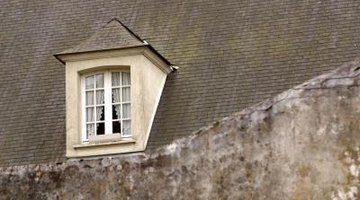Rot Damage on Dormer Siding
Wood rot is a sign of weather damage. This type of rot can occur on any outdoor siding, especially areas of your home that experience frequent exposure to moisture. Dormers are the high, peaked areas along your roofline that cover windows in upper stories or attics. The horizontal planes of siding along these structures are especially prone to rotting. Recognizing and repairing areas of wood rot around the dormer structures will help prevent further damage.
Cause

The rot that appears on the bottom portions of your dormers usually occurs when rain or snowmelt runs off the tops of the dormer roofs and splashes up on the bottom segments of the underlying dormer siding. Over time, this causes the wood to soak up the excess water and begin to rot. Even painted wood can eventually chip and fail under the constant onslaught of dripping, splashing water.
Characteristics
Rotting wood around your dormer can first appear as slightly swollen or misshapen wood. As the wood continues to expand and contract, the overlaying paint may crack and peel. Continued rotting can cause sections of the wood to crimple away. Depending on the amount of humidity in the area, mold growth can cause the wood to appear darker than the surrounding area, even during dry spells. Rotting dormer siding might also appear yellowish, stringy or spongy.
Repair
Depending on the extent of damage, you might need to replace entire sections of siding or just apply a new coat of paint. Don’t try to restore the appearance of the siding until you first correct the drainage problem responsible for causing the water damage that leads to the rotting.
Prevention
Eliminate constant splashing on the dormer siding by catching the water that runs off the top of the dormers. Install rain gutters along the bottom edges of dormer rooflines. Unlike the gutters along the edges of your house, these small sections don’t require downspouts. Instead, angle the gutters toward the back of the dormers. This will direct the flow of water leaving the roof to flow along the roofing shingles, rather than falling off the edge of the dormer and splashing up on the siding.
References
Writer Bio
Laura Wallace Henderson, a professional freelance writer, began writing in 1989. Her articles appear online at Biz Mojo, Walden University and various other websites. She has served as the co-editor for "Kansas Women: Focus on Health." She continues to empower and encourage women everywhere by promoting health, career growth and business management skills.
Photo Credits
- Hemera Technologies/AbleStock.com/Getty Images
More Articles



